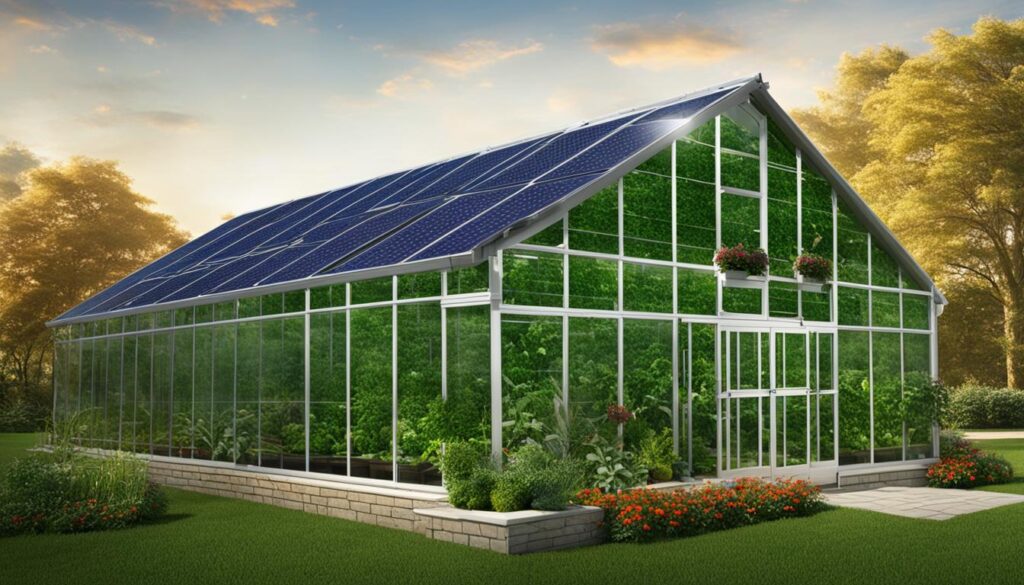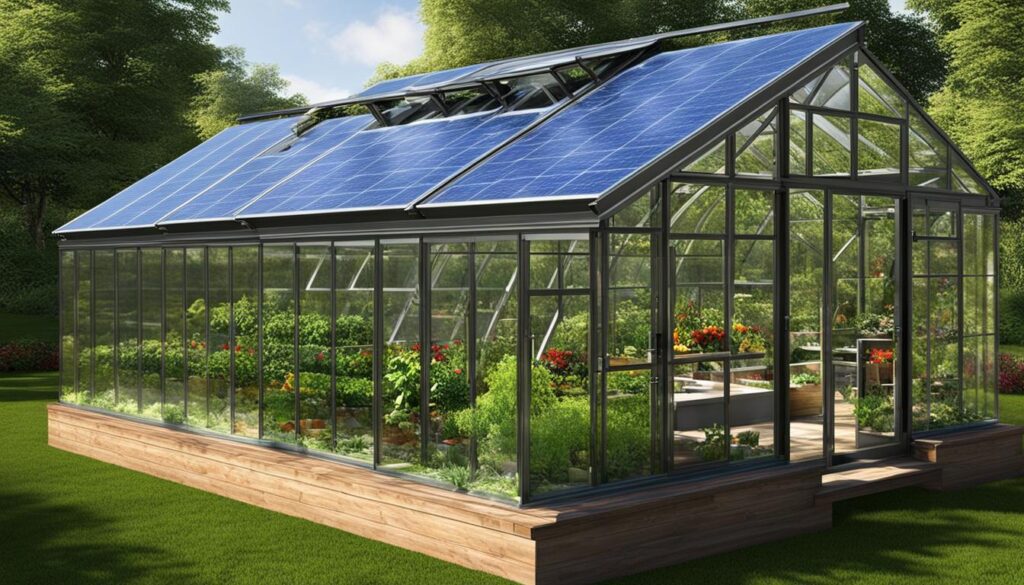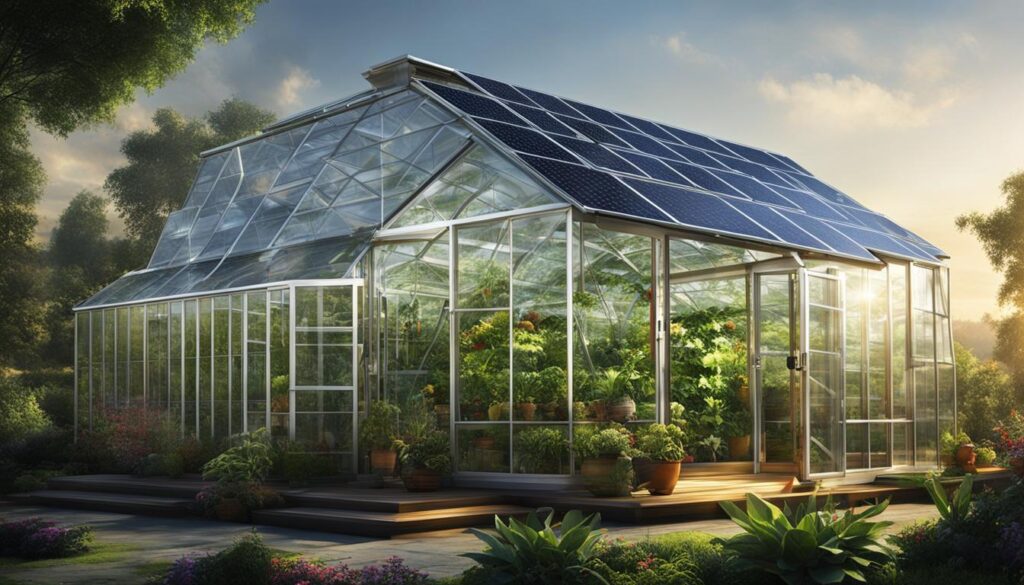With the increasing focus on renewable energy sources and sustainable practices, solar greenhouses have gained significant popularity in recent years. This comprehensive guide will provide you with all the information you need to harness clean energy and create an energy-efficient design for your greenhouse. From understanding the concept of a solar greenhouse to exploring its benefits and environmental impact, we will cover everything you need to know to get started on your journey to sustainable gardening.
Key Takeaways:
- A solar greenhouse combines the concept of a traditional greenhouse with the use of solar panels to harness energy from the sun.
- Solar greenhouses are more energy-efficient and environmentally friendly compared to traditional greenhouses.
- By using clean energy from the sun, solar greenhouses reduce carbon emissions and contribute to a more sustainable future.
- Advantages of solar greenhouses include reduced energy costs, lower carbon footprint, and the ability to grow plants year-round in a controlled environment.
- The design and functionality of a solar greenhouse play a crucial role in its success, with features such as passive solar design, greenhouse ventilation systems, and integration of renewable energy sources.
Understanding Solar Greenhouses and Their Benefits
Solar greenhouses are innovative structures that combine the concept of a traditional greenhouse with the use of solar panels, harnessing clean energy from the sun to create a sustainable gardening environment. These greenhouses provide numerous benefits for both the environment and the gardeners themselves.
What Is A Solar Greenhouse?
A solar greenhouse is a structure that utilizes solar panels to harness energy from the sun, providing heating and lighting for the plants inside. The design of a solar greenhouse creates a controlled environment that optimizes plant growth, allowing for year-round gardening.

Key Differences Between Solar and Traditional Greenhouses
The main difference between solar and traditional greenhouses lies in their energy sources. Traditional greenhouses often rely on propane, gas, or electricity for heating, while solar greenhouses use clean energy from the sun. By utilizing solar panels, these greenhouses reduce the reliance on fossil fuels and decrease carbon emissions, making them a more sustainable option for gardening.
The Environmental Impact: Carbon Emissions and Solar Greenhouses
Solar greenhouses have a significantly lower environmental impact compared to traditional greenhouses. By harnessing clean energy from the sun, solar greenhouses help reduce greenhouse gas emissions and contribute to the fight against climate change. The use of renewable energy sources in these greenhouses aligns with sustainable gardening practices, promoting a greener and more eco-friendly approach to growing plants.
Advantages: Why Choose a Solar Greenhouse for Sustainable Gardening?
There are several advantages to choosing a solar greenhouse for sustainable gardening:
- Reduced Energy Costs: Solar greenhouses rely on the sun’s energy, leading to significant savings on energy bills compared to traditional greenhouses.
- Lower Carbon Footprint: By utilizing clean energy, solar greenhouses help reduce carbon emissions, contributing to a healthier environment.
- Year-Round Growth: The controlled environment of a solar greenhouse allows for year-round gardening, providing the opportunity to grow crops and plants even during colder months.
- Optimal Plant Growth: Solar greenhouses create an ideal environment for plants, with precise control over temperature, lighting, and ventilation.
By leveraging the benefits of solar energy, solar greenhouses offer an innovative and sustainable solution for gardeners seeking to reduce their environmental impact while maximizing plant growth.
The Innovative Design and Functionality of a Solar Greenhouse
The design and functionality of a solar greenhouse are crucial for its success in harnessing clean energy. To achieve optimal performance, innovative design principles and features are employed to make solar greenhouses efficient and functional. This section will explore key aspects of solar greenhouse design, passive solar design, greenhouse ventilation systems, and the integration of renewable energy sources.
Solar Greenhouse Design:
Solar greenhouse design focuses on maximizing the utilization of solar energy for heating and lighting purposes. It incorporates various architectural elements and materials that optimize sunlight absorption and heat retention. The design factors in the orientation, glazing type, insulation, thermal mass, and shading devices to create an ideal environment for plant growth.
Passive Solar Design:
Passive solar greenhouse design is a fundamental principle in solar greenhouse design. It involves strategically placing glazing and thermal mass to capture and store solar energy efficiently. The goal is to maintain stable temperatures inside the greenhouse by utilizing the sun’s energy during the day and minimizing heat loss during colder periods. This approach reduces the reliance on mechanical heating systems, making the greenhouse more sustainable and cost-effective.
Greenhouse Ventilation Systems:
Proper ventilation is essential for maintaining a healthy and productive environment inside a solar greenhouse. Ventilation systems help regulate temperature, humidity, and air circulation, ensuring optimal conditions for plant growth. The design may incorporate vents, louvers, or fans to facilitate natural or mechanical airflow, allowing for efficient heat dissipation and moisture control.
Integration of Renewable Energy Sources:
To enhance the energy efficiency of solar greenhouses, renewable energy sources can be integrated into the design. This may involve the installation of solar photovoltaic panels to generate electricity for lighting or other electrical systems. Additionally, solar thermal systems can be utilized to provide supplementary heating during periods of low solar energy availability. The integration of renewable energy sources further reduces the overall carbon footprint and reliance on non-renewable energy.
By implementing innovative design principles and incorporating renewable energy integration, solar greenhouses offer a sustainable solution for gardening enthusiasts. Through passive solar design and efficient ventilation systems, these greenhouses provide a controlled environment for year-round plant growth while minimizing energy consumption and environmental impact.

Conclusion
The Future of Controlled Environment Agriculture with Solar Greenhouses
The future of controlled environment agriculture looks promising with the widespread adoption of solar greenhouses. These innovative structures have proven to be a game-changer in sustainable food production. Their energy-efficient design and sustainable features make them a viable option for controlled environment agriculture, ensuring a greener and more sustainable future. With the increasing demand for locally grown, pesticide-free produce, solar greenhouses can play a significant role in meeting the needs of the ever-growing population.
Year-Round Gardening and Energy Efficiency
One of the most significant advantages of solar greenhouses is the ability to grow plants year-round, regardless of the external climate conditions. This is made possible by harnessing the power of the sun to regulate the temperature and provide ample light for plant growth. The controlled environment inside a solar greenhouse ensures optimal conditions for plant growth, resulting in increased productivity and higher yields.
Moreover, year-round gardening in solar greenhouses reduces the reliance on artificial heating and lighting, leading to significant energy savings. By utilizing renewable solar energy, solar greenhouses minimize the use of fossil fuels and reduce carbon emissions. This not only benefits the environment but also lowers energy costs for farmers and cultivators.
In conclusion, solar greenhouses have the potential to revolutionize controlled environment agriculture, offering a sustainable and energy-efficient solution for year-round gardening. With their numerous benefits, including reduced energy consumption and increased productivity, solar greenhouses are paving the way for a more sustainable future in agriculture. By harnessing the power of the sun, we can create a greener and more resilient food system, ensuring food security and environmental sustainability for generations to come.
FAQ
What is a solar greenhouse?
A solar greenhouse is a structure that combines the concept of a traditional greenhouse with the use of solar panels to harness energy from the sun. It creates a controlled environment for plant growth by utilizing solar power for heating and lighting.
How do solar greenhouses differ from traditional greenhouses?
Solar greenhouses differ from traditional greenhouses in terms of their energy source. While traditional greenhouse heating systems rely on propane, gas, or electricity for heating, solar greenhouses use solar panels to generate heat and light. This makes them more energy-efficient and environmentally friendly.
What is the environmental impact of solar greenhouses?
Solar greenhouses have a lower environmental impact compared to traditional greenhouses. By using clean energy from the sun, they reduce carbon emissions and contribute to a more sustainable future.
Why choose a solar greenhouse for sustainable gardening?
There are several advantages to choosing a solar greenhouse for sustainable gardening. These include reduced energy costs, lower carbon footprint, and the ability to grow plants year-round in a controlled environment.
What are the innovative design principles of a solar greenhouse?
The design and functionality of a solar greenhouse are key factors in its success. Innovative design principles include passive solar design, greenhouse ventilation systems, and the integration of renewable energy sources for optimal performance.
What is the future of controlled environment agriculture with solar greenhouses?
Solar greenhouses have the potential to play a significant role in the future of controlled environment agriculture. Their energy-efficient greenhouse design and sustainable features make them a viable option for sustainable food production.
How do solar greenhouses contribute to year-round gardening and energy efficiency?
One of the key benefits of solar greenhouses is the ability to grow plants year-round, regardless of the external climate. This not only increases productivity but also reduces the energy required for artificial heating and lighting.

